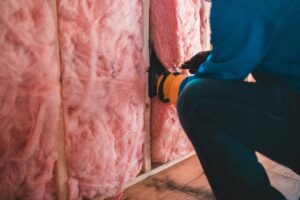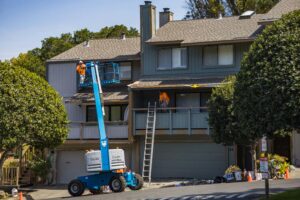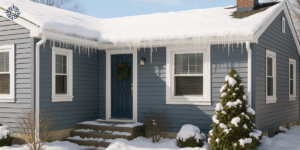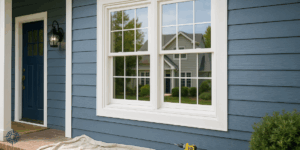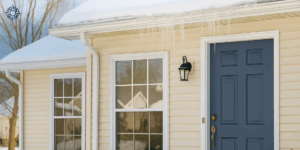What Are the Best Siding Materials for Homes?
That question has no single answer—because the best siding material for one home might be the worst for another. The strongest siding might not fit your neighborhood aesthetic, and the cheapest siding material might not offer the durability you need in a storm-prone climate. At Compass Exteriors, we help homeowners make informed, long-term decisions by weighing style, budget, durability, and maintenance.
This 2025 guide to siding materials compares the most popular types—vinyl, fiber cement, engineered wood, natural wood, metal, stucco, brick veneer, and composite—to help you find the best house siding material for your specific needs.
Vinyl Siding
Vinyl remains one of the most widely used types of siding materials, and for good reason. It’s affordable, versatile, and low maintenance.
- Cost: Lowest upfront cost of any mainstream siding option
- Durability: Resistant to rot, insects, and minor impact
- Appearance: Comes in a wide range of colors and textures that mimic wood grain
- Maintenance: Occasional rinsing with a garden hose is typically sufficient
While vinyl is not the strongest siding material, modern versions hold up well against UV fading and wind damage. However, it can crack in extreme cold and may not appeal to high-end buyers looking for premium finishes.
Fiber Cement Siding
Fiber cement siding, such as James Hardie®, offers a middle ground between beauty and performance.
- Cost: Mid-to-high range depending on finish and installation
- Durability: Fire-resistant, pest-proof, and rated for 30–50 years
- Appearance: Can closely mimic wood, stucco, or masonry
- Maintenance: Requires occasional repainting every 10–15 years
It performs well in a variety of climates and resists swelling, warping, and cracking. Fiber cement is heavier and more labor-intensive to install, but for homeowners seeking best house siding materials with timeless curb appeal, it’s a top contender.
Engineered Wood Siding
Engineered wood is made from wood fibers bonded with resin to create a lightweight, highly durable panel.
- Cost: Mid-range, typically less expensive than fiber cement
- Durability: Treated for moisture, mold, and pest resistance
- Appearance: Warm, authentic wood look without imperfections of natural lumber
- Maintenance: Requires repainting or resealing every 10–15 years
A rising favorite among homeowners, engineered wood delivers the aesthetic appeal of real wood with enhanced performance. It’s also faster to install and environmentally friendly due to efficient wood fiber use.
Natural Wood Siding
If you love a classic, warm exterior look, nothing matches the charm of real wood siding.
- Cost: Mid-to-high, depending on species (cedar and redwood are common)
- Durability: Naturally insect-resistant, but vulnerable to moisture and fire
- Appearance: Rich texture, customizable with stain or paint
- Maintenance: Requires consistent sealing or painting to prevent decay
Though beautiful, natural wood demands the highest maintenance. It’s ideal for those committed to hands-on care or living in drier climates. Wood can be a strongest siding material in terms of insulation but is less resilient to moisture over time.
Metal Siding
Often associated with modern homes and barndominiums, metal siding (steel or aluminum) is making a strong comeback.
- Cost: Medium to high, depending on type and thickness
- Durability: Excellent resistance to fire, insects, and rot
- Appearance: Sleek and contemporary; can be finished in multiple colors and patterns
- Maintenance: Extremely low; occasional rinsing is usually enough
Aluminum resists rust and is ideal for coastal regions, while steel is stronger and dent-resistant. Metal siding is energy efficient when paired with foam insulation and is among the best siding materials for homes in hail-prone or wildfire regions.
Stucco Siding
Stucco is a plaster-like exterior made from cement, sand, and lime, often used in Southwestern and Mediterranean-style homes.
- Cost: Mid-range
- Durability: Very durable in dry climates; less so in regions with frequent freeze-thaw cycles
- Appearance: Smooth or textured finishes available; can be tinted to any color
- Maintenance: Minor patching needed over time; repaint every 7–10 years
While beautiful and seamless, stucco can crack with foundation shifting or moisture penetration. It’s a smart option for dry, warm climates where its thermal resistance shines.
Brick Veneer Siding
Unlike structural brick, brick veneer is a thin layer applied to the home’s exterior, offering a classic look with less weight.
- Cost: High upfront investment
- Durability: Extremely durable and fire-resistant; can last a lifetime
- Appearance: Timeless and elegant; limited color variety
- Maintenance: Nearly maintenance-free
Brick veneer is ideal for homeowners who want a low-maintenance, upscale finish. While expensive, its longevity and curb appeal can contribute significantly to resale value.
Composite Siding
Composite siding blends polymers, fibers, or other engineered materials to create a highly customizable and durable finish.
- Cost: Mid to high depending on brand and composition
- Durability: Engineered for strength, resistance to rot, pests, and warping
- Appearance: Can mimic wood, stone, or smooth modern panels
- Maintenance: Typically needs minimal cleaning and resealing every 10–15 years
Composite materials are growing in popularity for those wanting the flexibility of design with reduced maintenance. Some options even come with 30–50 year warranties, making them a strong long-term investment.
Comparison Chart: Key Factors at a Glance
| Siding Material | Avg. Cost | Durability | Appearance | Maintenance Level |
| Vinyl | $ | 20–30 years | Wide variety | Low |
| Fiber Cement | $$–$$$ | 30–50 years | Classic & customizable | Medium |
| Engineered Wood | $$ | 20–30 years | Natural wood look | Medium |
| Natural Wood | $$–$$$ | 15–30 years | Rich, authentic | High |
| Metal (Steel/Alum.) | $$–$$$ | 40–70 years | Modern, sleek | Low |
| Stucco | $$ | 30–50 years | Smooth or textured | Medium |
| Brick Veneer | $$$ | 50+ years | Traditional, upscale | Very Low |
| Composite | $$–$$$ | 30–50 years | Varies widely | Low |
Cost ranges represent general material-only pricing.
Finding the Best Fit With Compass Exteriors
When it comes to answering the question, “What are the best siding materials for homes?” the real answer is: it depends on your priorities. Are you after the cheapest siding material for a quick flip? Or are you searching for the strongest siding material to protect your home for decades?
No matter your goals, Compass Exteriors is here to help. Our experts walk you through the pros and cons, help you match siding types to your architectural style and climate, and deliver expert installation that protects your investment.
Contact us today to schedule a free consultation. Let’s find the perfect siding for your home.


